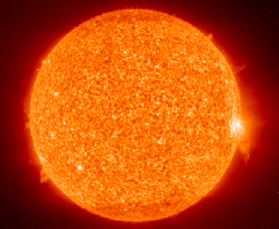Photosphere
The photosphere is typically regarded as the surface of our Sun. While the chromosphere resides above the photosphere, and, in turn, the corona envelopes the chromosphere, the density of the chromosphere and corona are so low that they are transparent. The photosphere is effectively the radial zone at which the density of ionised hydrogen atoms becomes low enough that the photons can escape unhindered. It is only a few hundred kilometres thick.
The typical temperature of the photosphere is some 6000oC, although relatively cool (4000oC) regions known as sunspots are not uncommon. Sunspots arise when strong magnetic fields inhibit the hot plasma from rising up through the underlying convection zone. When these magnetic field lines effectively break, the previously constrained material can burst free at high speeds in the form of solar flares.
The granulated, orange-peel like, appearance of the Sun originates from the photosphere. This texture is caused by the numerous convection cells within the underlying convection zone.
Study Astronomy Online at Swinburne University
All material is © Swinburne University of Technology except where indicated.


